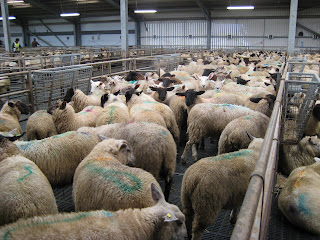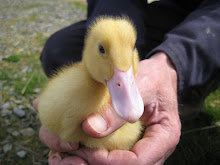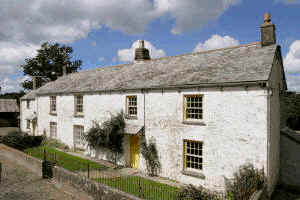 Health warning - don't scroll down if you'd rather avoid seeing pictures taken in an abattoir.
Health warning - don't scroll down if you'd rather avoid seeing pictures taken in an abattoir.I love a day when new words come pouring into my ear. Or when words I sort of think I kind of know, finally start to make sense.
Today was a day that I knew I would have to meet head on at some point. I've been trogging lambs and pigs to the abattoir for many years now, but I hadn't ever seen the process from start to finish. Thanks to the incredibly useful
EBLEX who run short courses for meat producers on all sorts of areas crucial to the farmer, I finally saw the whole story.
It's key that your animals are slaughtered at the right time: when they are at the best rate of fat to lean. Too fat, and they have to be trimmed and you've spent weeks feeding your livestock unnecessarily, expensively and to the detriment of your meat. Too lean, and you'll have a flavourless, scrawny chop on your plate and dissatisfied customers. A lamb is covered in fleece, so you have to get (gentle) hands on to find out when each individual lamb is ripe and ready. There's a Europe wide
classification system for lamb based on a combination of fatness and conformation used by every abattoir and every butcher and every supermarket and every wholesale and retail purchaser. Getting it right on a live animal is as much an art as a science. This is not something you absorb through rural osmosis, but something you have to be taught, and it has to be practised so you keep your hand in.
Today's course was held at a huge local abattoir, and run by two extremely knowledgeable, jolly and helpful experts. We looked at the charts, we had the pictures explained, and then we went to the
lairage (nice new word number one) to grade ten pre-selected lambs.
I fondled a scrawny article, a fat beast and one that was fat but had unequal conformation, and then another seven lambs along the spine, loin, shoulder, tail and between the legs to arrive at an estimated grade for each. Then it was on with the white boilersuit, hairnet and hard hat, a disinfect of wellies and hands, and into the processing area.

The scale of the thing took my breath away: a continuous line of machinery, people and lambs, with everyone focussed on their task, executing it cleanly, swiftly, carefully and with the right tools for the job. We were asked if we wanted to see the slaughter, and no-one baulked. It was so calm, professional, simple, with the layout designed to cause nil stress to the animal or the slaughterer. I watched several animals being stunned and throats cut. I wanted to make sure I saw the reality of where my animals are headed, and I felt nothing other than reassurance and thanks that such an important role in the food chain was being so expertly undertaken.
We followed the line as skins were removed, guts discarded (for deer this process is called
gralloching - second new word of the day) and offal inspected. We were shown examples of condemned livers - suffering from tapeworm or fluke and other parasites - and also arthritic joints that meant a leg or more might be spurned as unfit for human consumption.

Every liver and heart is kept alongside its carcase; if there is something wrong with these organs, the meat might also be compromised, and it is thoroughly checked. I saw the results of injecting against Bluetongue in the wrong muscles (the neck is the recommended place), and that lambs were being sent both too thin and too fat to slaughter.
We watched the professional grader determine the score of each lamb, the automatic weighing, the tingling with electric current, which reduces the need for hanging by tenderising the meat (hmm...not sure about that one), and then headed for the chiller, where the ten lambs we'd attempted to score were now tagged with the official result.

Out of the seven I'd guessed, I only got one spot on, but the other six were only one grade out, so I was reassured that I can pretty much tell what I'm looking for.
I take my animals to a small farm slaughter house, and the system is nowhere near as mechanised as this, but I will see if they can give me the condition scores and if my estimates improve.
And if you fancy a few more good meaty words in the gralloch mode, you gut a fish, paunch a rabbit and draw a chicken.
 So, this is the aftermath of the terrible fire that has utterly destroyed The George (this is what it looked like before the fire).
So, this is the aftermath of the terrible fire that has utterly destroyed The George (this is what it looked like before the fire).
 Just before Christmas I was in a church not a million miles away with a bunch of friends, listening to the most awful Christmas concert imaginable. Truly awful - I should have backed out when I heard the electric organ twang in lift musak fashion as I entered. There were candles everywhere, on all the pews and tucked into every churchy crevice.
Just before Christmas I was in a church not a million miles away with a bunch of friends, listening to the most awful Christmas concert imaginable. Truly awful - I should have backed out when I heard the electric organ twang in lift musak fashion as I entered. There were candles everywhere, on all the pews and tucked into every churchy crevice.



























































